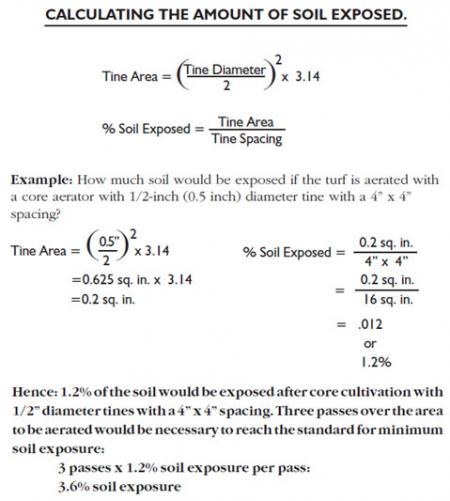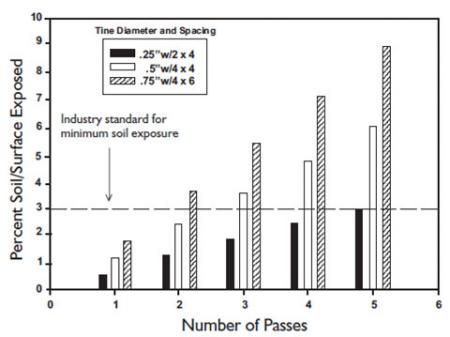Management of Compaction: Coring
A major contributor to poor aeration is soil compaction caused by vehicular and foot traffic. Soil compaction can create turf management problems caused by alterations in the physical properties of the soil including: decreases in total pore space, decreasing soil oxygen content, reductions in water infiltration and percolation rates, increases in soil strength and density, and increased water retention. No single management practice such as core cultivation is a cure-all for managing compaction. The turfgrass manager must also consider other management choices as part of the overall solution such as:
- selecting compaction tolerant species such as perennial ryegrass when overseeding key wear areas.
- regulating traffic by such practices as: moving tee markers and flag sticks on golf greens; rotating and using several practice fields for sports; restricting traffic during soggy or wet sports field conditions.
- adjusting cultural management practices including: using adequate nitrogen while avoiding excessive nitrogen; using multiple cycling when applying irrigation water until compaction is minimized; topdressing with appropriate rootzone sand mixes in combination with core cultivation to partially modify the rootzone to improve compaction resistance and drainage on sports turf surfaces.
Core Cultivation Equipment: Factors to Consider
Equipment Design:
There are two basic types of coring equipment: drum type and cam driven or vertically operating core cultivators. Both designs can be either walk behind, rider-operated units or mounted on a three-point hitch and driven attached to a tractor. Drum-type core aerators do not require the maintenance and cleaning that vertically operating cam types require. However the uniformity and depth of tine penetration with less surface disruption is superior with cam-driven units. In dry and compacted soil, weight must often be added to drum-type aerators in order to improve tine penetration.
Tine Diameter:
Tine diameter ranges from 1/4 to 3/4 inches (inside diameter). A 3/4 inch tine will remove more than twice the soil as a 1/2 inch diameter tine given the same tine spacing and depth of penetration. The more soil removed, the more soil deposited to the surface, and the greater the effect on modifying the thatch layer (and the more soil available for preparing a partial seedbed for overseeding). The exposed aerifier holes greatly increase available soil surface area which increases flow of nutrients, water, and air to roots. This stimulates root growth and ultimately shoot growth.
Tine Durability:
Generally large diameter tines are more durable because of heavier wall construction, although specially hardened small gauge tines are available for use on hard and abrasive soils. Open spoon tines are more durable and last longer than closed, hollow tines. However, open spoon tines remove only half the core length pulled by closed hollow tines which tend to remove a complete core. Finally, tines used on drum type aerators tend to last longer than tines used on cam type core aerators.
Tine Spacing:
Tine spacing can range from 2 to 6 inches and is available in various combinations such as 2" x 2", 2" x 4", 4" x 4", and 4" x 6". Generally, the tighter (closer) the tine spacing, the greater the contact area at any one time, and the more difficult the tine penetration. However, the more core aerifier holes per square foot of compacted soil and the greater the penetration depth, the greater the benefit in alleviating compaction, promoting rooting and gas exchange, and improving soil conditions.
Percent Soil Exposed:
Both tine diameter and tine spacing are important factors in determining the amount of turf surface and associated soil exposed and brought to the surface by a core cultivation event (see Example: Calculating the Amount of Soil Exposed). The industry standard for minimum soil exposure during cultivation by coring is 3 to 31/2 percent.
There is a variety of tine diameters, spacing, and aerator designs available. However, they are not necessarily equal in achieving this minimum standard with a single pass (see Figure 1). Most core aerators must make at least two or more passes to achieve the minimum 3% exposure in order to impact enough of the soil surface to afford any benefit (as shown in Figure 1).
The percent soil exposed should not exceed 10% because of excessive soil drying that may occur in and around aerifier holes and because of unacceptable surface disruption that can result. It is important to recognize that the depth of tine penetration is also a factor in determining the "volume" of soil exposed. Tine penetration depth is a critical factor for "bridging" impermeable layers that restrict rooting and internal drainage.
Core Cultivation Operations: Factors to Consider
Timing:
Core aeration is a disruptive process. A sufficient recovery period of 3 to 4 weeks of favorable growth should be permitted before the onset of high temperatures and drought during the summer or low temperatures of the winter prevent full recovery. Cultivation operations should be performed during peak shoot and root growth periods of early spring and early fall. If crabgrass infestation is a threat, avoid core aeration in the spring at peak germination time. Spring and early summer cultivation are preferred to fall when annual bluegrass infestation is a problem on golf course and sports turf. Otherwise, fall core cultivations are preferred when combined with fall overseeding, fertilization, and liming programs. Mid-summer aeration should be avoided because of the potential for excessive soil drying and the spread of diseases. If summer aeration is to be performed (for example, on a golf green), then small diameter solid tines (1/4 inch) should be used to limit soil drying, surface disruption, and play.
Frequency:
Heavily trafficked sites such as golf greens and sports fields may be aerated 4 to 6 times per year depending on the soil type and the extent of vehicular or foot traffic. Most lawn situations which receive little to no traffic will generally benefit from one or more core cultivations per year depending on the objectives. If only one aeration event is planned it should be coordinated with fall overseeding, fertilization, and lime applications.
Heavy Compaction:
For heavily compacted sites such as the key wear areas on athletic fields, consider using core cultivators with a tighter tine spacing and strive for maximum tine penetration depth (2-1/2 to 4 inches). Also, larger tine diameters are more durable, potentially remove more soil in these situations, and therefore have the greatest impact.
Soil Moisture:
Avoid cultivation when compacted soils are dry; this can increase machine stress and severely limit aeration effectiveness by limiting tine penetration to less than one inch. Turfgrass may be injured and slow to recover when the soil is too dry and hard. Consider irrigating the soil before aeration to the desired depth of penetration to ease soil strength and tine resistance. However, avoid core cultivation when the soil is "too wet" which can be counter-productive and actually increase soil compaction. (Note: if a freshly pulled soil core forms a tight ball when squeezed in the hand after releasing it, the soil is too wet for cultivation. Ideally the soil core should form a moist ball that crumbles in the hand after releasing it).
Thatch:
Thatch is often found in association with soil compaction because of the unfavorable soil conditions for microbial activity and thatch decomposition present. Remove any heavy thatch (1 inch or more) by verticutting or power raking before aerating. Break up aeration plugs immediately after aerating by using a drag mat, or piece of chain-link fence, by verticutting or power raking, or by using an old mower to scatter the soil containing-plugs. The scattered plugs will act as a topdressing material and help manage the thatch condition. Manage moderate levels of thatch (0.5 inch or less) by regular aeration and by returning broken plugs. However, where surface uniformity is critical such as golf on greens and tees, remove or break up cores immediately to avoid disrupting play.
--
Revised: 05/2011

